
The Berkeley Street Historic District is a historic district on Berkeley Street and Berkeley Place in Cambridge, Massachusetts. It encompasses a neighborhood containing one of the greatest concentrations of fine Italianate and Second Empire houses in the city. It was listed on the National Register of Historic Places in 1982, with a substantial increase in 1986.

The Building at 10 Follen Street is a historic house at 10 Follen Street in Cambridge, Massachusetts. The three-story wood-frame house was designed by Peabody & Stearns and built in 1875. It is a rare well-preserved example of the transition between Second Empire and Stick styles, with a truncated hip roof, a highly decorated porch, and most of its original interior woodwork.

The Oliver Hutchins House is an historic house at 79 Elm Street in Chelmsford, Massachusetts. The 2+1⁄2 story house was built in the 1820s, probably by Oliver Hutchins and his brother. The house's foundations and other stone elements indicate that the Hutchinses were probably associated with the local granite quarries in some way. The house is one of a few local houses that is transitional between Georgian and Federal styling: the basic plan of the house is Georgian, despite the lack of central chimney, and the exterior and interior woodwork are heavily influenced by the publications of Asher Benjamin.

The Bowers School is an historic school building on 411 Water Street in Clinton, Massachusetts. The two story brick schoolhouse was built in 1892 to a design by Joshua Thissell. The building was dedicated in honor of Rev. Charles Manning Bowers, a longtime member of the Clinton School Committee. The building was listed on the National Register of Historic Places in 1983. The building now houses residences.
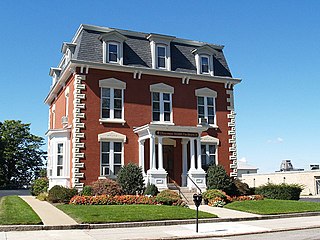
The David M. Anthony House is a historic house located at 368 North Main Street in Fall River, Massachusetts. Built in 1875 for a local businessman, it is one of the city's finest examples of Second Empire style. It was added to the National Register of Historic Places in 1983.

Narragansett Mills is a historic textile mill site located at 1567 North Main Street in Fall River, Massachusetts, United States. Built in 1872, it is a well-preserved example of a brick mill complex, somewhat unusual in a city where most of the mills are stone. It was listed on the National Register of Historic Places in 1983.
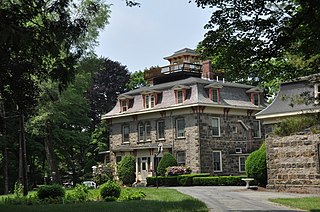
Stoneholm is a historic house in Sharon, Massachusetts. The 2+1⁄2-story stone house was built c. 1848, and is a distinctive Victorian house, exhibiting Second Empire and Italianate details executed in granite from the local Moyles Quarry near Borderland State Park. Built for Horace Augustus Lothrop. The house has a mansard roof with flared eaves, with a rooftop deck and cupola. The main facade is divided into three bays, with the entry in the central bay, sheltered by a wraparound single-story porch. The center bay on the second level has a pair of round-arch windows, a feature echoed in the roof dormer directly above.
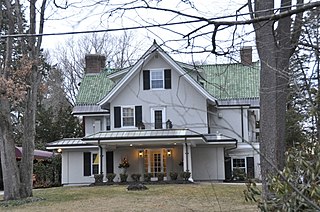
Orlando is the historic estate of William M. Wood Jr. in Andover, Massachusetts. Wood's father, William Madison Wood, was president and part owner of the American Woolen Company, whose home was the Arden estate next door to where Orlando was built. William M. Wood Jr.'s mother was Ellen Ayer Wood, the daughter of Frederick Ayer. Orlando is a distinctive Spanish Mission style mansion of 2.5 stories, with a green tile roof. The house was a wedding gift to Wood and his new wife, Edith Goldsborough Robinson, from his parents. The house was begun in 1916 and completed in 1917 to a design by architect Perley F. Gilbert, an Andover native who was then practicing in Lowell. The house's locally unusual Spanish Colonial-inspired architecture may have been influenced by the Wood family's summers in Florida.

The West Parish Center District encompasses the social and religious center of the part of Andover, Massachusetts, that is located west of the Shawsheen River. It is mostly spread along Lowell Street on either side of a major intersection with four other roads: Shawsheen Road, Reservation Road, Beacon Street, and High Plain Road. The centerpiece of the district is the 1826 West Parish Church, which is the oldest church standing in Andover. It is an elegant Federal style granite structure topped with a wooden steeple, added in 1863. The roof is made of Spanish tile, which was probably part of changes made around 1908. Opposite the church on the south side of the common is the West Parish Cemetery, which began as a small burying ground in the 1790s, and was substantially enlarged and restyled in the early 1900s.

Peabody City Hall is the historic city hall of Peabody, Massachusetts. It is located at 24 Lowell Street, near Peabody Square.

The Sewall-Scripture House, is a historic house museum in Rockport, Massachusetts that is owned by the Sandy Bay Historical Society. The Sewall Scripture Museum features antiques, period artifacts and items of local history. The Federal style building, the only house in Rockport built out of native granite, was added to the National Register of Historic Places in 1982.

The Joseph Damon House is a historic house in Reading, Massachusetts. Built about 1754, this 2+1⁄2-story wood-frame house is good local example of a Georgian colonial house with later Federal period alterations. It also demonstrates a typical pattern of shared ownership by multiple descendants of one of its owners. The house was listed on the National Register of Historic Places in 1984.

The Howe Building is a historic commercial building at 208 Middlesex Street in downtown Lowell, Massachusetts. The four story brick building was built in 1883, and is one of the city's finest Queen Anne commercial buildings. Its architecturally prominent features include a mansard roof, and a large central stepped gable with an arched window at the center. It was built by John F. and Henry C. Howe, brothers who were heavily involved in the commercial development of downtown Lowell who also sat on the city council.

The Worcester House is a historic house at 658 Andover Street in Lowell, Massachusetts. This vernacular Federal style farmhouse was built c. 1802 by Eldad Worcester, on land originally purchased by his grandfather, and is the oldest house on Andover Street. The area remained farmland through most of the 19th century. The house is architecturally unusual for the period, with a four-bay facade and its main entrance located on one of the sides.

The Wannalancit Street Historic District is a historic district at 14-71 Wannalancit St., and 390, 406 Pawtucket Street in Lowell, Massachusetts. This section of Wannalancit Street includes a remarkably well preserved and distinctive 19th century houses, representing a cross section of popular architectural styles of the period. The most unusual house in the district is the round Jonathan Bowers House ; the oldest building is a c. 1853 vernacular Greek Revival cottage at 22 Wannalancit Street.
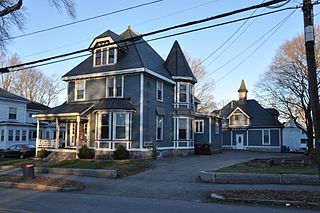
The Wilder Street Historic District is a historic district in Lowell, Massachusetts. The section of Wilder Street between Westford Street and Branch Road contains a remarkable collection of large late 19th-century houses. About one dozen wealthy businessmen built elaborate houses in Queen Anne, Italianate, Stick, and Second Empire styles in this area, which was developed by its landowner, Charles Wilder, and it was considered one of the city's most fashionable addresses of the time.

The Samuel Chamberlain House is a historic house at 3 Winthrop Street in Stoneham, Massachusetts. Built c. 1864, it is one of three well preserved Italianate side-hall style houses in Stoneham. It was listed on the National Register of Historic Places in 1984.

The Item Building is a historic commercial building at 26 Albion Street in Wakefield, Massachusetts. Built in 1912, the single-story brick building serves as the headquarters of The Wakefield Daily Item, Wakefield's main community newspaper, and is a well-kept example of early 20th century commercial architecture.

The Tiffany-Leonard House is a historic house at 25 Elm Street in Southbridge, Massachusetts. Built about 1832, it is a distinctive and high-quality local example of Greek Revival architecture, and is notable for its association with prominent local business owners. It was listed on the National Register of Historic Places in 1989.
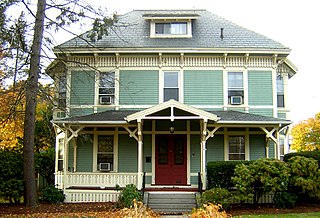
The George A. Barker House is a historic house located at 74 Greenleaf Street in Quincy, Massachusetts. Built in the late 1870s for the son of a local granite quarry owner, it is a good local example of Queen Anne architecture with Stick style details. The house was listed on the National Register of Historic Places on September 20, 1989.























